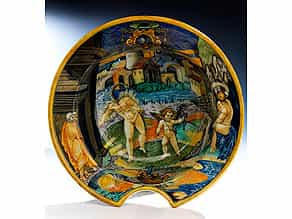Auction Maiolica
» reset
Your personal art agent

You would like to purchase a similar object?
We are happy to inform you, if similar works are to be auctioned in one of our upcoming auctions.
Please accept our privacy policy
533
Großes Majolika-Rasier-Becken von Francesco Xanto Avelli da Rovigo
Durchmesser: 33 cm.
Höhe: 11,6 cm.
Rückseitig monogrammiert mit trennenden Punkten "F X/R".
Urbino, um 1530.
Catalogue price € 14.000 - 18.000
Catalogue price€ 14.000 - 18.000
$ 15,120 - 19,440
£ 12,600 - 16,200
元 109,480 - 140,760
₽ 1,392,860 - 1,790,820
Tiefe Rasierschale mit partiell eingezogenem Rand. Die Schale ist mit Istoriato-Malerei verziert, die von einem gelben Band gerahmt wird. Dargestellt ist links Jupiter vor einer monumentalen Architektur, der Leda rechts erblickt, mittig ist er dabei, sich in einen Schwan zu verwandeln. Neben ihm steht ein kleiner Amorknabe, der einen Pfeil nach rechts zur Leda geschossen hat. Diese sitzt am rechten Bildrand auf der Fahne und vereinigt sich mit Jupiter in Schwan-Gestalt. Im Hintergrund eine Stadt am Wasser zu sehen. Die Unterseite zieren konzentrische Kreise. Oben das Wappen eines Kardinal mit Helm und Streifen auf dem Schild. Bemalung in Rot, Gelb, Blau, Grün und Schwarz. Bruchrest.
Anmerkung:
Die literarische Vorlage liefern Ovids Metamorphosen. Jupiter erblickte die schöne Leda und verliebte sich in sie. Um sich ihr unauffällig nähern zu können, verwandelte er sich in einen Schwan. Nach unterschiedlichen Überlieferungen bekam sie von ihm mehrere Kinder, die Dioskuren Kastor und Pollux, aber auch die schöne Helena soll aus der Verbindung hervorgegangen sein.
Literatur:
Für eine Darstellung der sukzessiven Verwandlung von Jupiter vgl. Rainer G. Richter (Hg.), "Götter, Helden und Grotesken. Das Goldene Zeitalter der Majolika", München, 2006, S. 142.
Sowie vgl. Johanna Lessmann, "Italienische Majolika. Katalog der Sammlung des Herzog Anton Ulrich-Museums Braunschweig", Braunschweig, 1979, S. 198, Nr. 185. (9300038)
Large maiolica shaving bowl by Francesco Xanto Avelli da Rovigo
Diameter: 33 cm.
Height: 11.6 cm.
Monogrammed with dots separating the initials on the reverse: F X/R.
Urbino, circa 1530.
Deep shaving bowl with semi-circular exclusion on the rim. The bowl is decorated with Istoriato painting and encircled by a yellow band. On the left, Jupiter in front of monumental architecture, beholds Leda to the right. At the centre, a scene showing him turning into a swan. A cupid stands next to him having fired an arrow in the direction of Leda to the right. On the right border Leda and Jupiter are joined in an embrace whilst Jupiter is in the guise of a swan. In the background a city by waters. Underside ornamented with concentric circles. The upper part shows the arms of a cardinal with a helmet and striped shield. Painted in red, yellow, blue, green and black. Broken and restored.
Notes:
The literary source for this scene originates in Ovid's Metamorphoses. Jupiter beholds the beautiful Leda and falls in love with her. In order to approach her inconspicuously he transforms into a swan. According to legend, she has several children with him, including the Dioscuri Castor and Pollux, and the beautiful Helena.
Literature:
For an illustration of the successive transformation of Jupiter, see Rainer G. Richter (ed.), Götter, Helden und Grotesken. Das Goldene Zeitalter der Majolika, Munich, 2006, p. 142, as well as Johanna Lessmann, Italienische Majolika. Katalog der Sammlung des Herzog Anton Ulrich-Museums Braunschweig, Braunschweig, 1979, p. 198, no. 185.
This object has been individually compared to the information in the Art Loss Register data bank and is not registered there as stolen or missing.
Your personal art agent
You would like to be informed of upcoming auctions if a similar work of art is offered? Activate your personal art agent here.
Please accept our privacy policy
You would like to purchase a similar object?
Your personal art agent Purchase in Private Sale Calendar
Our experts are happy to support you personally in your search for art objects.
You would like to sell a similar artwork in auction?
Consign now Private Sale Service FAQ
Your consignments are always welcome.
Our staff will be happy to personally assist you every step of the way. We look forward to your call.
Get in touch with our experts
further catalogues Furniture | 16th - 18th Century Paintings | Porcelain, silver, rock crystal | Library | Sculpture and Works of Art | Ceramics | Maiolica | Hampel Living | 19th - 20th Century Paintings | Russian Art | Modern Art | Asian Art, Jewellery & Watches | Books, drawings and engravings | Folk Art and Miscellaneous




















